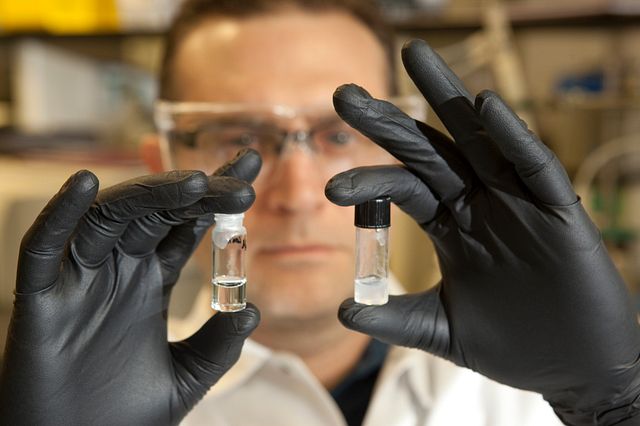GMP Stability Testing Programs
Protein, peptide, vector, and plasmid products are particularly sensitive to environmental factors. Stability testing studies are performed to evaluate biopharmaceutical products under various environmental conditions over a specific timeframe. The results determine recommended storage and shipment conditions for drug substances and products, and determine the appropriate shelf life or retest period.
Real-time and Accelerated Stability Testing
Shelf life is commonly estimated using results from both real-time stability and accelerated stability tests. In real-time stability testing, a product is stored at recommended storage conditions and monitored until it fails product specifications. In accelerated stability testing, a product is stored at elevated stress conditions (e.g., high temperatures and/or humidity). Degradation at the recommended storage conditions can then be predicted using known relationships between the acceleration factor and the degradation rate.
Forced Degradation Studies
We support forced degradation programs with stability studies that use extreme storage conditions in order to increase the rate of degradation. Due to the non-linear nature of protein degradation kinetics, these studies have limited value in shelf-life prediction for biopharmaceutical products. However, because they provide information on product breakdown and degradation pathways, forced degradation studies are particularly useful in early drug development to improve formulation and assist with the determination of storage conditions to control product stability.
-
Advanced Analytical Methods Supporting Stability Testing
Our team is skilled in a wide range of stability indicating analytical techniques using the latest instrumentation, including:
- 1D and 2D SDS-PAGE
- Western blot
- Isoelectric focusing
- Peptide mapping of proteins and peptides using reverse-phase HPLC with UV and/or mass spectroscopy detection
- Stability-indicating chromatography (e.g., reverse-phase, size-exclusion ion exchange, and hydrophobic interaction chromatography)
- Sulfhydryl analysis
- N- and O-linked glycosylation/carbohydrate analysis
- Capillary electrophoresis including cIEF ,CE-SDS and CZE
- Protein content/concentration
- Spectrophotometric analysis (e.g., UV-Vis, fluorescence and circular dichroism)
- Determination of pH, dissolution, appearance and colorFormulation-specific testing (e.g., subvisible particulates, moisture content)
- Total active ingredient determination by ELISA or immuno-ligand assay
- Potency assays including cell-based, in vivo models, ELISA, and binding by SPR
- Container closure integrity
- Endotoxin, microbial enumeration, and sterility testing
-
GMP Storage Conditions for Stability Studies
- LN2 cryogenic freezers
- 17 40K dewars and five dewars at various sizes
- capacity and setup to scale-up to add an additional 20 40k dewars as needed
- Broad range of ICH compliant and custom/customizable walk-in and reach-in storage conditions:
- 25 ˚C/60% RH
- 30 ˚C/65% RH
- 40 ˚C/75% RH
- 30 ˚C
- 5 ˚C
- -20 ˚C
- -70 ˚C
- LN2 cryogenic freezers
Long-term Stability Studies
For biopharmaceutical products, long-term stability studies are conducted under the intended storage conditions, with shorter duration studies performed at higher temperatures to support in-use stability and shipping conditions. Lower temperature conditions are often included in the program to provide baseline, non-stressed values and to prevent delays if the intended storage condition proves to be unsuitable. Our experienced staff will assure that your stability study is conducted under the appropriate conditions for your biologic.
Frequently Asked Questions (FAQs) about Stability Testing
-
What is pharmaceutical stability testing?
Stability Testing is the process for determining, through storage at defined conditions and testing at specific intervals, how long a drug substance or product remains safe and effective at particular storage conditions.
-
What is accelerated stability testing?
The use of higher temperature to increase the kinetics of product degradation in order to predict how long a material can remain stable at a lower temperature is considered accelerated stability testing. It does not really apply to biological products where multiple degradation pathways are possible and the kinetics are complex.
-
How do you perform stability testing?
Samples are stored under set conditions and tested at intervals using a subset of the release specification assays that are known to be indicative of product stability. The tests are initially performed quite frequently, but the duration between testing occasions extends as more is known about the product’s behavior.
-
What are ICH guidelines for stability studies?
The International Conference on Harmonization provides a forum for regulators from around the world (initially USA, Japan and Europe) to agree a single set of guidelines describing study requirements that will be acceptable to all and thus allow global registration with a single study. There are multiple agreed guidelines associated with the design and interpretation of stability studies. Our team bases all study designs on the International Conference on Harmonization (ICH) guidelines Q1A(R2): Stability Testing of New Drug Substances and Products and Q5C: Quality of Biotechnological Products – Stability Testing of Biotechnological/Biological Products. Where possible, we apply bracketing and matrix designs in accordance with ICH document Q1D.

